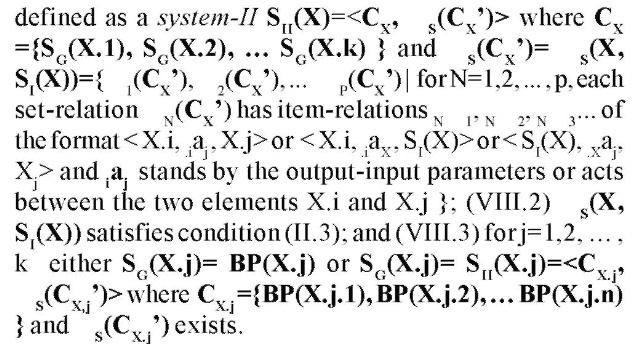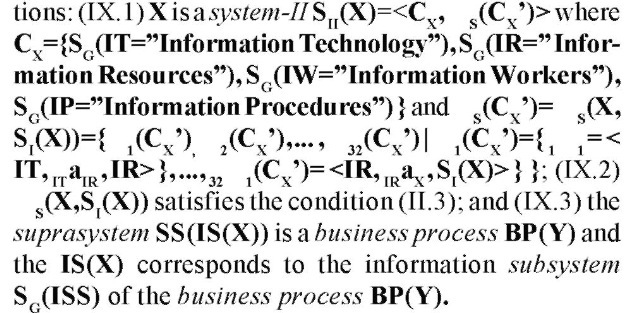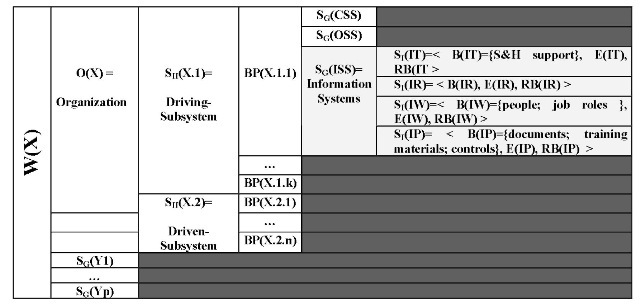INTRODUCTION
The information systems (IS) field has been recognized as a scientific discipline since the 80′s, as indicated by: (i) the existence of an intellectual community related with doctoral programs and research centers around the world that generates scientific knowledge and solves practical problems using standard scientific procedures accepted and regulated by this community, and (ii) the diffusion of scientific knowledge related with IS through research outlets and research conferences under a rigorous peer-based review process.
Nonetheless, the discipline of information systems has been critiqued by: (i) the lack of formal theories (Farhoomand, 1987, p.55); (ii) the scarce utilization of deductive and formal (e.g., logical-mathematical) research models and methods (idem, p.55); and (iii) the lack of a formal and standard set of fundamental core well-defined concepts associated with the central object of study in this discipline (Alter, 2001, p.3; Banville & Landry, 1989, p.56; Wand & Weber; 1990, p.1282). Consequently, a common-sense language based on informal, conflicting and ambiguous concepts is used as the communicational system in this discipline (Banville & Landry, 1989), and this approach hinders the development of a cumulative research tradition and delays the maturation of the field (Farhoomand, 1987; Wand & Weber, 1990). Furthermore,a deep examination (Mora, Gelman, Cervantes, Mejia, & Weitzenfeld, 2002) of definitions of the term information system, reveals that fundamental concepts are based on few and misused core concepts from the theory of systems (Ackoff, 1960, 1971) and the few formalization proposals (Alter, 2001; Mentzas, 1994; Wand & Weber, 1990) are incomplete.Therefore, the reduction of the lack of formalization of the core concepts used in the IS discipline becomes a relevant and mandatory research purpose. This article contributes to the IS literature with the adaptation and extension of previous formal definitions reported of the terms system (Ackoff, 1971; Gelman & Garcia, 1989) and organization (Mora, Gelman, Cervantes, Mejia, & Weitzenfeld, 2002) based on the core principles from the Theory of Systems and with the proposal of a formal definition of the term information systems. The article also examines the implications for IS research and practice.
BACKGROUND
The term information system (IS) has been widely defined in text topics. Table 1 shows a sample of the main definitions posed in the literature. An examination of these definitions suggests that the IS notion: (i) lacks fundamental standardized and formal concepts (Alter, 2001); (ii) lacks competitive formal macro-structures to cumulate theories (Farhoomand & Drury, 2001, p. 14); and (iii) has an excessive variety of micro-theories (Barkhi & Sheetz,2001).
Table 1. A sample of informal definitions of “what is an information system”
| Definition | Reference |
| “An IS is a system composed of subsystems of hardware, programs,. files and procedures to get a shared goal. “ | (Senn, 1989, p.23) |
| “An IS is a system composed of application software, support software, hardware, documents and training materials, controls, job roles and people that uses the software application”. | (Hoffer, George & Valacich, 1996, p.8) |
| “An IS is a system composed of inputs, models, outputs, technology, data bases and controls.” | (Burch & Grudnitski, 1989, p.58) |
There have been few, if any, efforts to formalize the discipline. Despite attempts to reduce ambiguity, the proposals (Alter, 2001; Wand & Weber, 1990) have been underpinned on partial views – e.g., syntactical and structural perspectives that hide core semantic information – of what is a system (Mora, Gelman, Cervantes, Mejia, & Weitzenfeld, 2002; Sachs, 1976). Others (Mentzas, 1994) offer a more articulated definition than exhibited on Table 1 – by the identification offive subsystems and their functional properties – still lack formalization due to they were developed using a common-sense language critiqued in the IS literature (Banville & Landry, 1989). Therefore, the concept information system has still multiple meanings. A systems-based research stream (Alter, 2001; Mora, Gelman, Cervantes, Mejia, & Weitzenfeld, 2002; Paton, 1997) combined with an ontological perspective (Wand & Weber, 1990) suggest that formal foundations from the Theory of Systems (Xu, 2000, pp.113) can reduce this ambiguity and strengthen the rigor that a scientific discipline requires to mature and simultaneously to be relevant and useful for practitioners.
MAIN THRUST OF THE ARTICLE
Formalization reported in this article is adapted and extended from previous work by the authors on the formal concepts of system (Gelman & Garcia, 1989) and organization and business process (Mora, Gelman, Cervantes, Mejia, & Weitzenfeld, 2002). This conceptual development follows a ontological path to define primitive concepts and postulates to derive updated definitions of the constructs system-I, system-II, general-system, organization, business process and finally information system. A similar approach was used by Wand and Weber (1990) and Wand and Woo (1991) to define what is an information system and what is an organization.
Formal Definition of System-I. An object of study X, formalized as system-I and denoted as SI(X)=<B(X),RB(X),E(X)>, is a whole X that fulfills the following conditions: it has a conceptual structure §(X) that defines its set of attributes B(X), its set of events E(X) and its set of range of attributes RB(X); (I.2) for any subset B’(X) of attributes of B(X), the set of events E(X) associated with B(X) differs in at least one element from the set of events E’(X) associated with B’(X).
Therefore, to define a situation of study as a system-I implies to specify SI(X) = <§(X)> =<B(X), E(X), RB(X)> and to fulfill the condition (I.2).
Formal Definition of System-II. An object of study X, formalized as system-II and denoted as SII(X)=<CX,
![tmpFA-1_thumb[4] tmpFA-1_thumb[4]](http://lh5.ggpht.com/_1wtadqGaaPs/TEq5iVyl_OI/AAAAAAAAKA8/CB1CfOXTYvY/tmpFA1_thumb4_thumb.jpg?imgmax=800)
output-input parameters or acts between the two elements}; and (II.3) exists at least a non-directed-path among two any items Xi and Xj in the set-relation S(CX’).
It must be noted that: (i) condition II.3 assures that for any two elements Xi and Xj in the multi-digraph X, Xi is reachable from Xj and vice versa; (ii) it is a recursive definition to let a subsystem has subsystems; and (iii) this definition updates previously reported by authors to consider the output/input relationships between any subsystem and the whole system. Therefore, to define a situ-

Formal Definition of System as General-System. An object of study X, formalized as general-system and denoted as SG(X), is a whole X that can be defined simultaneously as a system-I SI(X) and as a system-II Sn(X).
Postulate 1. Any general-system SG(X) defined as system-I SI(X) can be mapped to a system-II SII(X) and vice versa.
Auxiliary Definition 1. Suprasystem. A whole SX is called the suprasystem of a system X and it is denoted as SS(X) if (IV.1) the whole X is a subsystem of SX; and (IV.2) SX can be formalized as SI(SX) or SII(SX).
Auxiliary Definition 2. Envelope. A whole EX is called the envelope of a system X and it is denoted as EE(X), if (V.1) the whole EX is the suprasystem of the suprasystem of X; and (V.2) EX can be formalized as SI(SX) or SII(SX).
Auxiliary Definition 3. Environment. A whole WX is called the environment of a system X and it is denoted as W(X), if(VI.1) WX can be formalized as SI(WX) or SII(WX) and (VI.2) W(X)={SS(X), EE(X)}.
Postulate 2. Any general-system SG(X) has a suprasystem SS(X) and an envelope EE(X).
The first formal definition of the concept system - for example, system-I – accounts for the conception of an external view that sees the system as a single-unit with special characteristics – called, attributes – and potential acts to execute – called, events. In turn, the second formal definition – for example, system-II – represents the more usual view – for example, the internal view – that sees the system as a digraph. Furthermore, the definitions of the set-relations 1(CX’), 2(CX’), m(CX’) consider the system as a multi-digraph instead of digraph and therefore eliminates some limitations of classic digraph-alike definitions critiqued in the systems theory’s literature (Sachs, 1976). Auxiliary definitions and the second postulate help to support the expansionist systemic perspective that indicates that every system always belongs to other larger system (Ackoff, 1971).
Formal Definition of Business Process as System. An object of study X is called a business process and denoted as BP(X) if satisfies the following conditions: (VII.1) X can

It must be noted that the item-relations S1 to S12 take into account at least all possible interrelationships between any two subsystems and of them with the whole system BP(X).
Formal Definition of Organization as a System. An object of study X is called an organization and denoted as O(X) if satisfies the following conditions: (VIII.1) X can be

Therefore, a business process can be considered a system with three subsystems: control, operational and informational. In turn, an organization is a system composed of at least two general-systems that in turn can be either a business process or a system-II composed by businessprocess. This general definition offers modeling freedom according to the scope of a specific research. In this article, we will use a cybernetic management perspective of organizations that suggests that any organization is composed by two subsystems called the driving or management and the driven or productive subsystems, respectively (Gelman & Negroe, 1981, 1982). Management subsystem can be composed of the planning, decision-making, financial and controlling subsystems, and the productive subsystems in turn can be composed by manufacturing, logistic, marketing, and sales/post-sales subsystems. However, it must be noted that general definitions of what is an organization can adopt other management perspectives such as Porter’s added-value chain. In that case, it would be necessary to consider three subsystems:of the primary activities, of the support activities and of the top management activities. With these previous antecedents, the formalization of what is an information system is straightforward.
Formal Definition of Information System as System. An object of study X is called an Information Systems and is denoted as IS(X) if fulfills the following condi-

Figure 1 presents a visualization of all formal concepts reported. Due to space limitations, all notation of the item-relations of all systems-II are hidden. Also, all item-relations into the subsystems of the information system are represented by the four arrows grouped in a single shape. The formal definition posed indicates that an information system, as a system, is a part of a larger system, that is, a business process system, that in turn, is the suprasystem of the IS denoted as SS(IS). Full dots represent the concentration of the subsystems’ outputs towards the environment of the system. In turn, clear dots represent the concentration of the environment’s inputs into the system. Therefore full and clear dots are useful to take into account the dual specification of any system either as system-I – for example, a monolithic view – or as system-II – for example, a multi-digraph view.
FUTURE TRENDS
We claim that the proffered formal definition offers a flexible framework to model and specify an information system in the level of detailed demanded by the researchers or practitioners. Four possible applications are briefly presented under a theoretical and practice perspective: (i) formal integration of the common-sense concepts used into the informal definitions of what is an information system; (ii) elimination of the ambiguity caused by the “Siamese Twin Problem” (Alter, 2001, pp. 30-31); (iii) analysis of failures on information systems through the systemic classification of problems; and (iv) generation of conceptual and dynamic simulation models of information systems.
(i) The formal approach offers a flexible framework consistent with previous definitions of an IS. For example, Table 2 exhibits a straightforward way to within its environment. Furthermore, since the formalisms posed can be extended through the addition of parameters in the set of a-actions in the item-relations, it is possible to model social, technical and political features through the specification of attributes and events assigned to subsystems in the system’s environment W(BP(X)), where BP(X) represents the suprasystem of the IS under study. For example, soft features as <top management support>, <environmental hostility>, <environmental dynamism> and <organizational climate>, once specified and measured, can be easily assigned as subsystems’ attributes of W(BP(X)). (iv) Complex conceptual and dynamic-based simulations models of IS can be specified. A case in point is the recent development of a conceptual and system dynamic-based simulation model of the implementation process of Decision-Making Support Systems (Mora, Cervantes, Gelman, & Forgionne, 2003, 2004) that generated satisfactory predictive results from several well-known reports in the literature.
Table 2. Example of formalization of Hoffer et al.’s (1996) definition of information systems

In short, this article suggests that the formal definition of the term information system, developed from the formal principles of theory of systems, enables researchers and practitioners to: (i) avoid ambiguity from informal definitions; (ii) account for practically all informal definitions; (iii) specify and customize a structure of the concept IS with the level of detail demanded by the modelers; and (iv) help to build complex systemic models of organizations that use IS. However, since formalisms in the information systems field have been scarcely reported, it is strongly recommended that further research be conducted to deploy their benefits and cope their limitations.
CONCLUSION
This article supports the thesis that formalisms - from the theory of systems – are required in the field of information systems to reach the rigor and maturation needed for a respectable scientific discipline. However, gains will not be free since researchers and practitioners could be required to add to his/her conceptual tools the utilization of logical-mathematical models. Perhaps, then, the information systems discipline will no longer be a “fragmented adhocracy” (Banville & Landry, 1989, p.56). Formalisms posed offer a non-trivial way to understand and model an information systems and therefore contribute toward the maturation of our field.
KEY TERMS
Attribute (Informal Definition): A substantial feature of a whole that is perceived by an observer with the potential to produce or cause a product or effect.
Event (Informal Definition): An act performed by a whole or to the whole that is perceived by an observer directly or through its consequences on other(s) whole(s).
Subsystem: Any immediate inner system that is subsumed to the system.
Suprasystem: The immediate outer system that subsumes any system.
System (Informal Definition): A whole composed of subsystems, and at the same time included in a suprasystem in such way that some particular properties of the whole and of the subsystems are getting lost when they are considered analytically, for example, by separation of the parts of the whole.
Theory of Systems: A research inquiry paradigm based on an expansionist world view, a synthetic and holistic thought and teleological principles, which makes it suitable and effective for studying complex phenomena.
